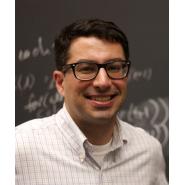非常抱歉,
你要访问的页面不存在,
非常抱歉,
你要访问的页面不存在,
非常抱歉,
你要访问的页面不存在,
验证码:

职称:Professor
所属学校:University of Chicago
所属院系:chemistry
所属专业:Chemistry, Other
联系方式: (773) 702-2330
My group and I develop and apply theoretical and computational approaches for relating biological behavior to underlying molecular interactions. Our effort is in three broad areas: Physical models of biological systems: Because the defining properties of life (growth, movement, and directed response to environmental stimuli) rely on irreversible energy consumption and dissipation, much of our research centers on the statistics of stochastic systems far from equilibrium. This is an exciting time in this area as basic principles have emerged over the last two decades, and there is now the opportunity to explore how they apply in real systems in order to realize their potential for designing and interpreting experiments. To this end, my group and I are working to develop phenomenological models in close collaboration with researchers acquiring data amenable to quantitative analysis (e.g., cellular images, expression levels, forces). We have worked on cytoskeletal, circadian, and developmental problems in reconstituted systems with purified components, cell lines, bacteria, flies, and mice. Enhanced sampling algorithms: One feature that makes studies of biological behavior challenging is that the relevant dynamics span a hierarchy of time and length scales ranging from Ångstroms and femtoseconds to millimeters and days. Experiments are now beginning to bridge the gaps in spatial and temporal resolution, and models are vital for design and interpretation of such measurements. Corresponding simulations require methods that can increase exploration of states that are rarely visited in comparison with the time scale of molecular fluctuations (e.g., transition states) while still enabling recovery of unbiased statistical averages. We developed some of the most general and efficient methods available for accelerating the convergence of properties of microscopically irreversible models (nonequilibrium umbrella sampling and steered transition path sampling); we are now working with applied mathematicians to analyze these methods rigorously to improve and extend them. Additionally, we are exploring dimensional reduction techniques (i.e., automated methods for identifying physically informative reaction coordinates in complex systems) to aid in interpreting simulations and connecting them with experimental observables. Reverse engineering regulatory networks: Extensive data from high throughput (e.g., genome-wide) experiments are now available for many biological systems, but it remains unclear how best to use this information to formulate mechanistic and predictive models. We introduced, validated, and deployed the first approach for combining binding and expression measurements to identify long-range (in DNA sequence) gene regulatory targets of transcription factor binding events (EMBER: Expectation Maximization of Binding and Expression pRofiles). We continue to investigate methods for integrating diverse types of data for better elucidation of molecular interactions.
My group and I develop and apply theoretical and computational approaches for relating biological behavior to underlying molecular interactions. Our effort is in three broad areas: Physical models of biological systems: Because the defining properties of life (growth, movement, and directed response to environmental stimuli) rely on irreversible energy consumption and dissipation, much of our research centers on the statistics of stochastic systems far from equilibrium. This is an exciting time in this area as basic principles have emerged over the last two decades, and there is now the opportunity to explore how they apply in real systems in order to realize their potential for designing and interpreting experiments. To this end, my group and I are working to develop phenomenological models in close collaboration with researchers acquiring data amenable to quantitative analysis (e.g., cellular images, expression levels, forces). We have worked on cytoskeletal, circadian, and developmental problems in reconstituted systems with purified components, cell lines, bacteria, flies, and mice. Enhanced sampling algorithms: One feature that makes studies of biological behavior challenging is that the relevant dynamics span a hierarchy of time and length scales ranging from Ångstroms and femtoseconds to millimeters and days. Experiments are now beginning to bridge the gaps in spatial and temporal resolution, and models are vital for design and interpretation of such measurements. Corresponding simulations require methods that can increase exploration of states that are rarely visited in comparison with the time scale of molecular fluctuations (e.g., transition states) while still enabling recovery of unbiased statistical averages. We developed some of the most general and efficient methods available for accelerating the convergence of properties of microscopically irreversible models (nonequilibrium umbrella sampling and steered transition path sampling); we are now working with applied mathematicians to analyze these methods rigorously to improve and extend them. Additionally, we are exploring dimensional reduction techniques (i.e., automated methods for identifying physically informative reaction coordinates in complex systems) to aid in interpreting simulations and connecting them with experimental observables. Reverse engineering regulatory networks: Extensive data from high throughput (e.g., genome-wide) experiments are now available for many biological systems, but it remains unclear how best to use this information to formulate mechanistic and predictive models. We introduced, validated, and deployed the first approach for combining binding and expression measurements to identify long-range (in DNA sequence) gene regulatory targets of transcription factor binding events (EMBER: Expectation Maximization of Binding and Expression pRofiles). We continue to investigate methods for integrating diverse types of data for better elucidation of molecular interactions.